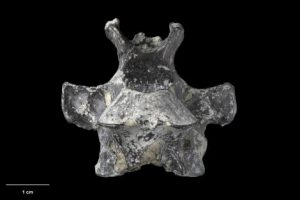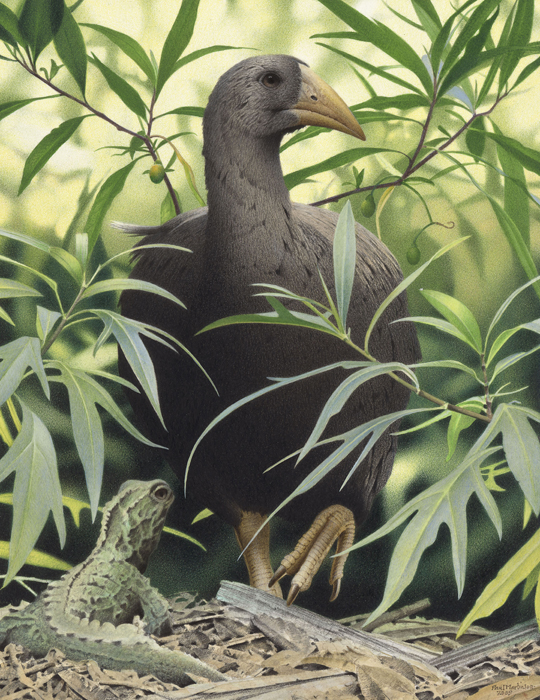As a kid, I remember visiting Canterbury Museum with my Dad. I was fascinated and terrified in equal measure by the giant moa skeleton in the entrance, just as my four-year-old is today. But what really interested me was the much smaller, but not less diminutive, skeleton of an extinct adzebill.
The adzebills were built like tanks. They sported massive adze-like beaks and skulls. These were in turn supported on a long neck made up of heavily reinforced vertebrae. With very little in the way of wings, these giants walked around on equally robust legs and feet.

Weighing in at 16-19 kg, (some estimates place their weight as high as 25 kg), and up to one-metre-tall, adzebills would have been formidable flightless birds indeed. When Polynesians arrived that fateful day in Aotearoa around 750 years ago, these stocky birds inhabited the drier eastern areas of the North (Aptornis otidiformis) and South (Aptornis defossor) Island, before quickly going the way of the moa as a result of over-hunting.
Enigmatic as they may be, adzebills are also birds shrouded in mystery, much like the artist Banksy. Their origins and palaeoecology are seemingly lost in the mists of time. Where did they come from, and when? What did they eat? What did they use their massive beaks and powerful legs for? Grubbing in the dirt or holding down their prey and stabbing it have all been suggested. These big questions have been tempting scientists ever since Sir Richard Owen, the famous anatomist, first described adzebills in 1844, ironically not from their infamous skull, but from a leg bone.
Seeking the answers to these questions epitomises the phrase “the nearest thing to studying life on another planet”, coined by Jared Diamond about our unique biodiversity. And yet, as Mike Dickison, New Zealand’s Wikipedian-at-large, says “almost nobody in New Zealand has heard of them”. However, recent discoveries are beginning to lift the veil of mist that has shrouded these birds for over 170 years.

So what do we know? Fossils from the Miocene Wonderland at Saint Bathans suggest adzebills have been an integral part of our unique biodiversity for at least 16-19 million years. The Saint Bathans adzebill (Aptornis proasciarostratus, from “pro, before, ascia, Latin for adze, and rostratus, Latin adjective for beaked”) suggest a flightless bird only slightly smaller than its more recent descendants.
Palaeontologists have placed adzebills, based on the general shape of their bones, within the Gruiformes, the order of birds that includes rails and their allies – think of the more familiar weka, takahē and pūkeko. But that’s where the trail runs cold. The bones of adzebills are so modified from their long evolutionary history in Aotearoa that their detailed whakapapa has been all but obscured with the passage of time. Adzebills have been compared to other large Gruiforms like the New Caledonian kagu (Rhynochetos jubatus) and the South American sunbittern (Eurypyga helias), to no avail. Adzebills are good at keeping secrets…until now.
An international team, led by Alex Boast from Manaaki Whenua Landcare Research, and including our own Canterbury Museum and Te Papa Tongarewa, have used ancient DNA to pull back the mists of time to reveal the true identity of the adzebills. And it’s no less fascinating. Adzebills are indeed Gruiforms, but in a surprise twist, these enigmatic birds are most closely related to the Sarothruridae. This family of birds, which even fewer people (including me) have probably heard of, comprises the Madagascan wood rails (Mentocrex spp.) and the diminutive African-Madagascan flufftails (Sarothrura spp.), the latter of which weigh less than 50 grams.

Molecular dating suggests that the tūpuna of adzebills arrived in Aotearoa via long-distance dispersal about 40 million years ago, with dates ranging from around 25-54 million years ago. Africa and Madagascar had separated from the southern supercontinent Gondwana long before this, approximately 100 million years ago, suggesting the ancestors of adzebills were true globe trotters. It’s likely they arrived here after a long haul flight, or equally possible, via an OE through Antarctica, which wasn’t the frozen continent it is now. Liking what Aotearoa had on offer, they decided to stay, but went extinct everywhere else.
Think this story sounds familiar? Well, you would be right. Ancient DNA and morphology, (the shape of bones), has shown that our national bird, the kiwi, is most closely related to the extinct giant flightless Madagascan elephant birds. The kiwi’s ancestors were also globe trotters and flew here around 50 million years ago.
So why did the tūpuna of adzebills, which probably weighed a meagre 280 grams, undergo a 50-fold increase in size from their arrival 40 million years ago, to the giant Saint Bathans adzebill we would have no trouble recognising, roaming the shores of the palaeo Lake Manuherikia 16-19 million years ago? It’s likely that they exploited a job vacancy in the prehistoric New Zealand ecosystem ideally suited to them and got there first.
If, however, these tūpuna arrived after the ‘Oligocene drowning’ around 25 million years ago, as the range of arrival times suggest, then their size increase is very impressive indeed, only topped by the rapid gigantism in the extinct Haast’s Eagle (Hieraaetus moorei) and Eyles’ Harrier (Circus teauteensis). These top avian predators are actually the descendants of Australians who moved across the ditch to greener pastures around 2.3-2.5 million years ago. Not only that, but just like the adzebills, they are most closely related to some seriously small forebears. In this case, the comparatively tiny little eagle (Hieraaetus morphnoides) and booted eagle (Hieraaetus pennatus), and the small to medium-sized spotted harrier (Circus assimilis).
The Saint Bathans adzebill, and the molecular dating, suggests these tank-like birds evolved in the South Island and only moved into the North Island relatively recently, around 0.2-2.3 million years ago. This timing coincides with the formation of a land bridge between both islands around 1.5-2 million years ago, closing the Manawatu Strait, long before the formation of the formidable Cook Strait around 450,000 years ago. The inhabitants of the North Island wouldn’t know what hit them with the arrival of adzebills, possibly quite literally.

Which brings us to another enduring mystery, one of many concerning adzebills. What powered these tanks? Jamie Wood from Landcare Research may just have the answer. Stable dietary isotopes (think you are what you eat) from adzebill bones can be used to reconstruct the habitat (13C) and trophic level (15N) of these mysterious birds. In an ingenuous study that eliminated geographical and temporal variation in isotopic signatures that can muddy the waters, Jamie showed that adzebills had a high trophic position in Aotearoa’s prehistoric ecosystem, relative to their contemporaries. Whether this means adzebills were predators or scavengers is not known. All we know is that adzebills enjoyed a good steak, served very rare and possibly smelling a bit funky.
Some mysteries may never be solved, but that’s what makes science fascinating. Adzebills are good at keeping secrets. For me personally, I think it should stay that way, as a metaphor for how weird and wonderful life can be on islands and Aotearoa in particular. But also as poster birds to attract our tamariki to seek out the secrets hidden in New Zealand’s past. So the next time you are at Canterbury Museum, take another look at the adzebill skeleton in the entrance, and think, imagine even, those penguins from the Madagascar movies had nothing on this kiwi badasses.
Featured Image: North Island adzebill (Aptornis otidiformis). Artwork by Paul Martinson © Te Papa CC-BY-NC-ND 4.0.


I don’t understand the need to replace actual taxonomic/phylogenetic terms with Maori words that have similar (not the same) meanings.
-SG
I think it’s because it makes it more relatable to New Zealander’s and the general public rather than using complicated scientific terms that not everyone understands.